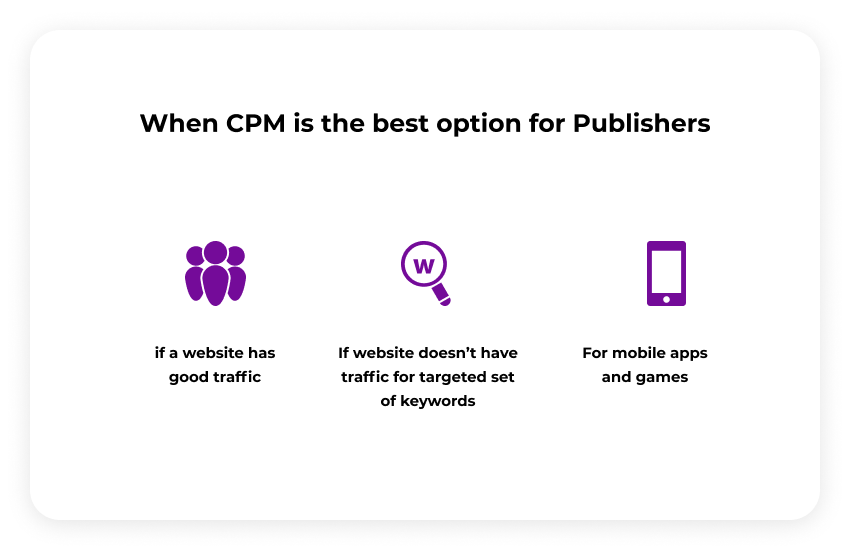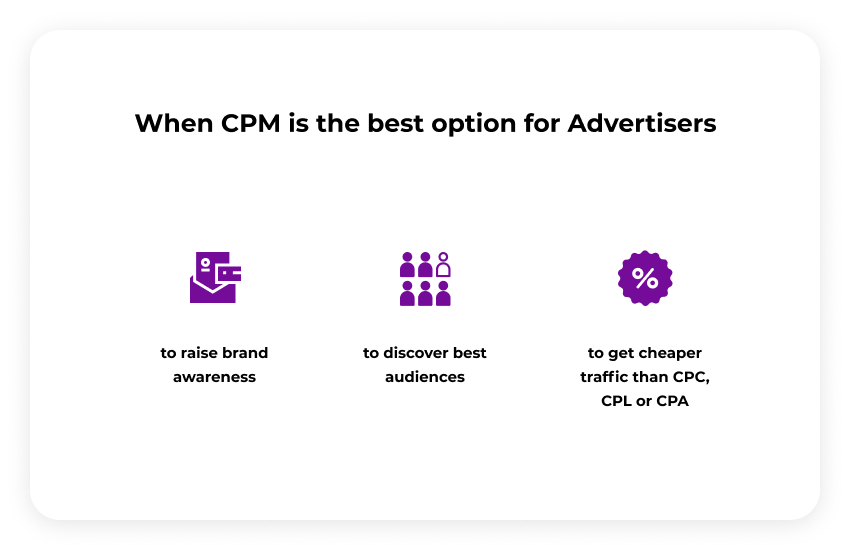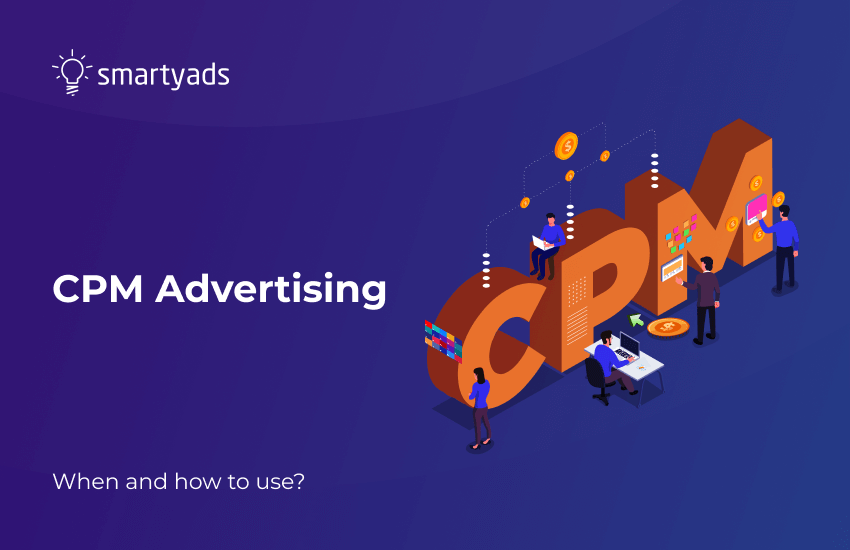There are several types of pricing models for digital programmatic advertising and online advertising. They include CPI, CPC, CPA, and, of course, CPM (CPT) — the most popular method for pricing web ads used in digital marketing and display advertising.
CPM stands for "cost per mille", where "mille" is a Latin word that stands for "thousand". For every thousand impressions, advertisers pay publishers a certain amount of money. The CPM model is represented in almost every ad network, so it is among the most popular and requested today. Let's find out how CPM rates are determined and what are the benefits of CPM strategies.
Importance of CPM Marketing in the digital advertising landscape
In the dynamic world of digital marketing, CPM (Cost per Thousand Impressions) advertising holds immense importance for advertisers and marketers. Here's why CPM advertising is crucial for your digital marketing efforts:
- It boosts brand visibility and awareness;
- It efficiently reaches specific target audiences;
- It provides cost control and predictability;
- It offers valuable insights into brand exposure;
- It provides flexibility and scalability;
- It complements performance marketing campaigns;
- It integrates with retargeting and remarketing efforts.
How does CPM work? (determining ad spend with CPM metric)
First, measure the total number of served ad impressions. Then, divide it by 1000. Now, divide the budget of your digital advertising campaign by that number.
CPM and other pricing methods: how it is different from CPC and CPA
The CPM pricing model is popular in Internet advertising because it is simple — users are not expected to do any actions, like click on online ads, install apps/buy something. But how effective is it if you compare it to other pricing methods?
Cost per completed view implies that users should watch the online video ad till the end (entirely); only in this case, it will be counted as completed.
CPT advertising: what's this?
CPT advertising refers to the cost per thousand impressions
It is just another way to call this model (cost per thousand vs. cost per mille). Thus these two notions are interchangeable; these two are the same model used for measuring ad spending.
Cost per thousand can be considered a more traditional pricing model, and this is sometimes precisely what an advertiser needs, e.g., for brand awareness campaigns. This is why programmatic buying most frequently deals with a CPM revenue model.
CPM vs. CPC (Cost per Click):
CPM: In CPM ads, marketers pay for every thousand impressions their ad receives, regardless of whether users click on it. It focuses on brand exposure and reaching a wide audience.
CPC: In CPC advertising, marketers pay each time a user clicks on their ad. This model emphasizes driving traffic and actual user engagement. Advertisers only pay when someone interacts with their ad by clicking on it.
Cost per click and cost per action
CPC and CPA pricing models stand for cost per click and cost per acquisition respectively. Typically with CPC, an advertiser or marketer pays only for the number of clicks the ad generates.
In the CPA model, display advertisement is supposed to generate sales. For such campaigns, marketers pay only when the transaction is made on the web page.
CPM vs. CPA (Cost per Action)
CPM: CPM pricing is based on the number of impressions without requiring a specific action from users. It aims to increase brand visibility and awareness.
CPA: CPA advertising charges based on specific actions or conversions, such as purchases, sign-ups, or submission forms. Advertisers pay only when users perform the desired action.
CPM vs. CPV (Cost per View)
CPM: CPM advertising charges based on impressions, meaning each time an ad is displayed or loaded on a web page or app. The focus is on the potential exposure of the ad to users.
CPV: CPV advertising charges based on the number of views or interactions with video ads. Marketers pay when a user watches a certain portion of a video ad or engages with it in a predefined way.
Benefits of CPM in advertising for publishers and developers
Let us now look at other online advertising pricing models and see how CPM differs.
CPM is preferable by publishers as with this online advertising model, they don't risk anything; ad revenue is counted after each ad serving.
- No additional efforts
It is easier to monetize inventory with the CPM model. CPM is simple; however, in order to serve advertisements on the CPM advertising platform publisher's advertising inventory should reach a particular bar of daily user views.
- No need to gather website keywords
With CPM ads, publishers don't even have to select keywords for their website targeting. Programmatic advertising is created to personalize each impression for every viewer, so keywords are not needed.
- Performance is easy to count
How to calculate CPM
To calculate how much profit publishers can get by placing CPM ads, they can use different estimations — an average number of served ad impressions and daily-active-users count. The CPM rate is also indicative. Ads served on mobile devices have a lower CPM but still have impeccable performance.

Why should advertisers use CPM strategies (how CPM works)
So why are CPM strategies so frequently used in digital marketing? Here's what media buyers say:
- To raise brand awareness, recall, and get a high traffic
As we have already mentioned, using this method is a perfect CPM strategy for building a strong audience and raising brand awareness. Cost per click ad campaigns, meanwhile, will better suit performance campaigns.
- To easily reach the right audiences
Using this model to build your target audience persona and introduce your brand to them is also a good move.
- Marketing performance is easily measured
The campaign's success can be measured using different metrics, but one of the most popular is CTR which stands for click-through rate. It is calculated as a percentage of people who clicked on your ad once they encountered it. For example, 5 clicks from 100 display ad views on ad placement will give you 5% CTR (click-through rate), 8 clicks for 100 impressions gives 8% CTR, and so on. Same, you can calculate CPM.
- This common method is more affordable than CPC and CPA
Example
Price per 1000 ad views is a model that can potentially generate more clicks and user actions than other models (for the same amount of money). The cost per impression is lower than the cost per click, so companies pay less.
For instance, advertising costs $20 (CPM campaign), and the total value for pay per click campaign is $20 (for, let's say, 50 clicks on the advertisement). As soon as you get 50 clicks, the CPC campaign is finished. While it's hard to predict how many ad clicks the CMP campaign will generate, theoretically, you can get up to 1000 clicks on the ad for the same money.

Choosing advertising technology for a campaign
For programmatic advertising platforms like demand-side platforms, delivering the right marketing messages to the right users at the right site or app is easy.
You are probably familiar with such programs (even if you don't think you are). For example, Google Display Network is one of the most popular programs of this type.
There are numerous reasons to run CPM campaigns on DSPs:
- It's easy to track ad performance — you can choose a period and see how many digital views you obtained during that time, how many clicks those generated, win rates, etc.;
- There are plenty of formats available for the cost per thousand (CPM) impression segment: banners, display ads, in-app and mobile ads, CTV, etc.;
- Certain DSPs have specifically developed functionality that optimizes the total cost per thousand.
How to optimize CPM impressions you bind on? (or improving the CPM rate for a CPM deal)
On SmartyAds DSP, advertisers can set up a bid cap so that system will take it as a maximum bid threshold it never exceeds.
In addition to this, SmartyAds DSP has a feature called CPM optimizer. With this function activated, media buyers (advertisers) will receive more impressions for the same CPM. During the real-time bidding process, it learns the specifics of the purchased ad placements and the dynamics of the bidding process. It will automatically adjust the CPM bid price, decreasing the price per each when possible (just for a sufficient optimal level to win the impression).
Best Practices for CPM Ads
When launching any advertising campaign, there are a few basic rules that must be followed in order to succeed. Let's take a look at these rules for CPM marketing campaigns:
Setting clear campaign objectives
Clearly define your goals and objectives before launching a campaign. Determine whether your focus is on brand awareness, reach, conversions, or another specific outcome.
Set measurable key performance indicators (KPIs) that align with your objectives, such as the number of impressions, click-through rates, or engagement metrics.
You can tailor your CPM strategy, targeting, and messaging by establishing clear objectives.
Monitoring and optimizing ad performance
Regularly monitor the performance of your CPM ads using analytics tools or platforms. Keep track of key metrics, such as impressions served, click-through rates, conversion rates, and engagement levels.
Analyze the data to identify trends, patterns, and areas for improvement. Determine which ad creatives, placements, or targeting options are performing well and which may need adjustments.
Optimize your ad campaigns based on insights gathered from data analysis. Make data-driven decisions to refine your targeting, adjust bidding strategies, or update ad creatives to enhance performance.
A/B testing and experimentation
Conduct A/B testing by running multiple versions of your ads simultaneously to identify the most effective elements. Test different ad creatives, headlines, calls to action, or landing pages.
Split your target audience into smaller segments and test different variations within each segment. Create a separate web page for each audience segment if needed. This allows you to gather insights on what resonates best with different audience subsets.
Experiment with different ad placements, platforms, or targeting options to discover new opportunities for optimization.
Continuously iterate and refine your ad campaigns based on the results of A/B testing and experimentation. Implement the learnings to improve your ad performance over time.
Summing it up
Whereas pay-per-click and pay-per-action are better suited for performance campaigns, CPM campaigns turned into the industry standard as they are winning for brand awareness and drawing in web traffic. The advertiser pays less; additionally, the CPM campaign itself can potentially generate more clicks out of 1000 impressions if the advertising offer is interesting to the users.
Start getting benefits from the CPM campaign on SmartyAds DSP!




